
Smoke over Vancouver. Smoke rising from downtown riots after the Canucks' game 7 loss in the Stanley Cup Finals: photo by Matthew Giepengieser, 15 June 2011
i Two Destinies (the surveyors, 1792)
Had it not been for him Spanish
Oregon would go all the way up
to Alaska -- and probably no hockey
Discovery and Chatham
George Vancouver, R.N.
a gentleman of King's Lynn
out one morning looking
for the Northwest Passage bumped in
to the Sutil and the Mexicana
two goletas from San Blas
out surveying.............mapping
.....the northern and the
........eastern limits
...........of the New World
ii.Vancouver and Bodega
George Vancouver....explorer and navigator
ventured up Tahsis Inlet with
Juan Francisco de la Bodega y Quadra
to visit Maquina's fishing village
three English pinnaces a Spanish launch
Vancouver the topographer of landscape
'winding inland by a deep valley'
................between steep fjords
forests taller than masts
with fifes and drums.....ship's musicians
.........-- 'a martial solemnity'
'to the no small entertainment of the natives' --
to imitate the Indian custom played
'vociferous songs & plaintive airs'
.......in the late summer twilight
Maquina came to dinner......a tent pitched
'in a fine meadow
.........delightfully skirting
...............a small bay'
iii ceremony at Maquina's village
by light of day
boats paraded
colours of distant kings
then royal parley
in the chief's great lodge
on cedar mats
and bentwood
imperial regalia -- Spaniards
Englishmen -- Maquina's
four wives
and many children --
benches lined with skins
matrix-issue ceremony
King's daughter the princess
bearer to the male heir
Vancouver and Bodega
white chiefs as witness
ceremonial transfer
of would-be rights
entailment-bestowal
diplomacy
protocol (mutual)
European
and 'native'
iv a feast
Royal kitchen
singing & feast
in a corner
cooks busily employed
Stews & Fricasees
boiling Oil
Porpoise Whale Seal
'such delicious meets
thrown away on us
as it turned out
we had a far better
dinner to sit down to'
agreed on setting out
'Don Quadra
should furnish the eatables
Captn. Vancouver the
Drinkables'
v the dance
Maquina loaned his Spanish chain mail
and soldier's helmet
to his brother for the dance
'a complete Suit of Stage Armour
very likely once the property
of Hamlet's Ghost'
the dancers mimed belligerent
people of strange coasts
China England Spain Owyhee
N. W. of Greenwich so remote
wild black eyelash time
bird down and red ochre
clung to fishoiled hairdos
a masque of assault by stealth
a show of bravado 'advancing
with eyes steadily fixed'
down on Indian nation
painted-face warriors brandished
muskets & spears
toward the (unnerved) commanders
stomped swung clubs
drummed gun butts
on the ground in unison
pre-attack chants
and long martial songs
'all fierce & Warlike
style & subject
one or two of them ended
with a frightful yell
to a strangers ear
terrific'
vi potlatch party
Had it not been for him Spanish
Oregon would go all the way up
to Alaska -- and probably no hockey
Discovery and Chatham
George Vancouver, R.N.
a gentleman of King's Lynn
out one morning looking
for the Northwest Passage bumped in
to the Sutil and the Mexicana
two goletas from San Blas
out surveying.............mapping
.....the northern and the
........eastern limits
...........of the New World
ii.Vancouver and Bodega
George Vancouver....explorer and navigator
ventured up Tahsis Inlet with
Juan Francisco de la Bodega y Quadra
to visit Maquina's fishing village
three English pinnaces a Spanish launch
Vancouver the topographer of landscape
'winding inland by a deep valley'
................between steep fjords
forests taller than masts
with fifes and drums.....ship's musicians
.........-- 'a martial solemnity'
'to the no small entertainment of the natives' --
to imitate the Indian custom played
'vociferous songs & plaintive airs'
.......in the late summer twilight
Maquina came to dinner......a tent pitched
'in a fine meadow
.........delightfully skirting
...............a small bay'
iii ceremony at Maquina's village
by light of day
boats paraded
colours of distant kings
then royal parley
in the chief's great lodge
on cedar mats
and bentwood
imperial regalia -- Spaniards
Englishmen -- Maquina's
four wives
and many children --
benches lined with skins
matrix-issue ceremony
King's daughter the princess
bearer to the male heir
Vancouver and Bodega
white chiefs as witness
ceremonial transfer
of would-be rights
entailment-bestowal
diplomacy
protocol (mutual)
European
and 'native'
iv a feast
Royal kitchen
singing & feast
in a corner
cooks busily employed
Stews & Fricasees
boiling Oil
Porpoise Whale Seal
'such delicious meets
thrown away on us
as it turned out
we had a far better
dinner to sit down to'
agreed on setting out
'Don Quadra
should furnish the eatables
Captn. Vancouver the
Drinkables'
v the dance
Maquina loaned his Spanish chain mail
and soldier's helmet
to his brother for the dance
'a complete Suit of Stage Armour
very likely once the property
of Hamlet's Ghost'
the dancers mimed belligerent
people of strange coasts
China England Spain Owyhee
N. W. of Greenwich so remote
wild black eyelash time
bird down and red ochre
clung to fishoiled hairdos
a masque of assault by stealth
a show of bravado 'advancing
with eyes steadily fixed'
down on Indian nation
painted-face warriors brandished
muskets & spears
toward the (unnerved) commanders
stomped swung clubs
drummed gun butts
on the ground in unison
pre-attack chants
and long martial songs
'all fierce & Warlike
style & subject
one or two of them ended
with a frightful yell
to a strangers ear
terrific'
vi potlatch party
party followed -- shaman's dance
....''dextrous Pantomimical tricks
......with his Hat & Mask'
pulling strings & changing faces
.....................a schlepper
came forth now with
......prime skins
.........of sea otter
..............for the guests --
the king's mouthpiece
speechifying --
Vancouver answered back
....with a fife
........and drum reel --
Maquina ecstatic --
Vancouver promised fireworks --
Isla de......................on their way back
Quadra.....................the relieved captains
y Vancouver...............named the island
..............................
TC: from Empire of Skin, 1997
Petroglyphs believed to have been made by the Hupacasath people, Sproat Lake Provincial Park, near Port Alberni, British Columbia: photo by Kevstan, 2008
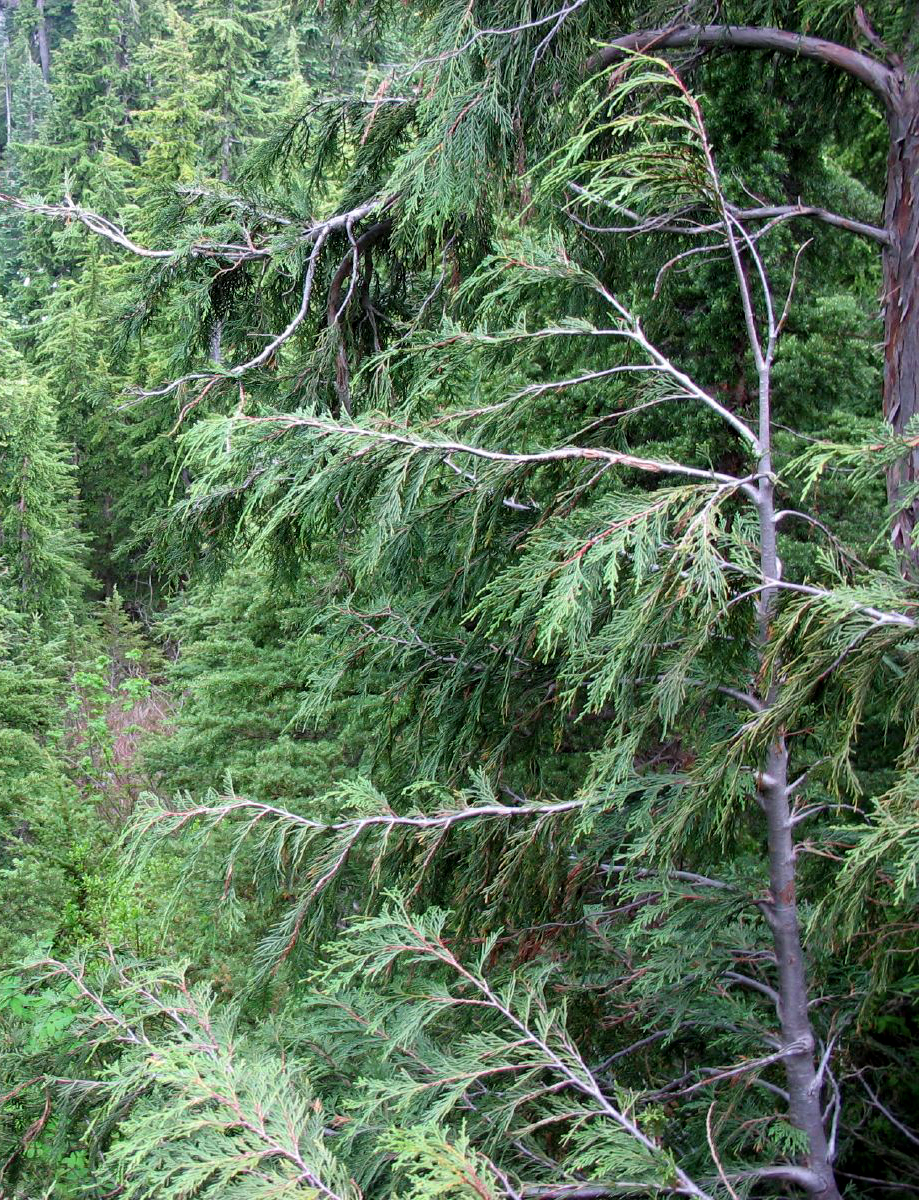
Nootka cypress (Cupressus nootkaensis) foliage, Mount Seymour Provincial Park, Vancouver: photo by Michael Scheltgen, 2006
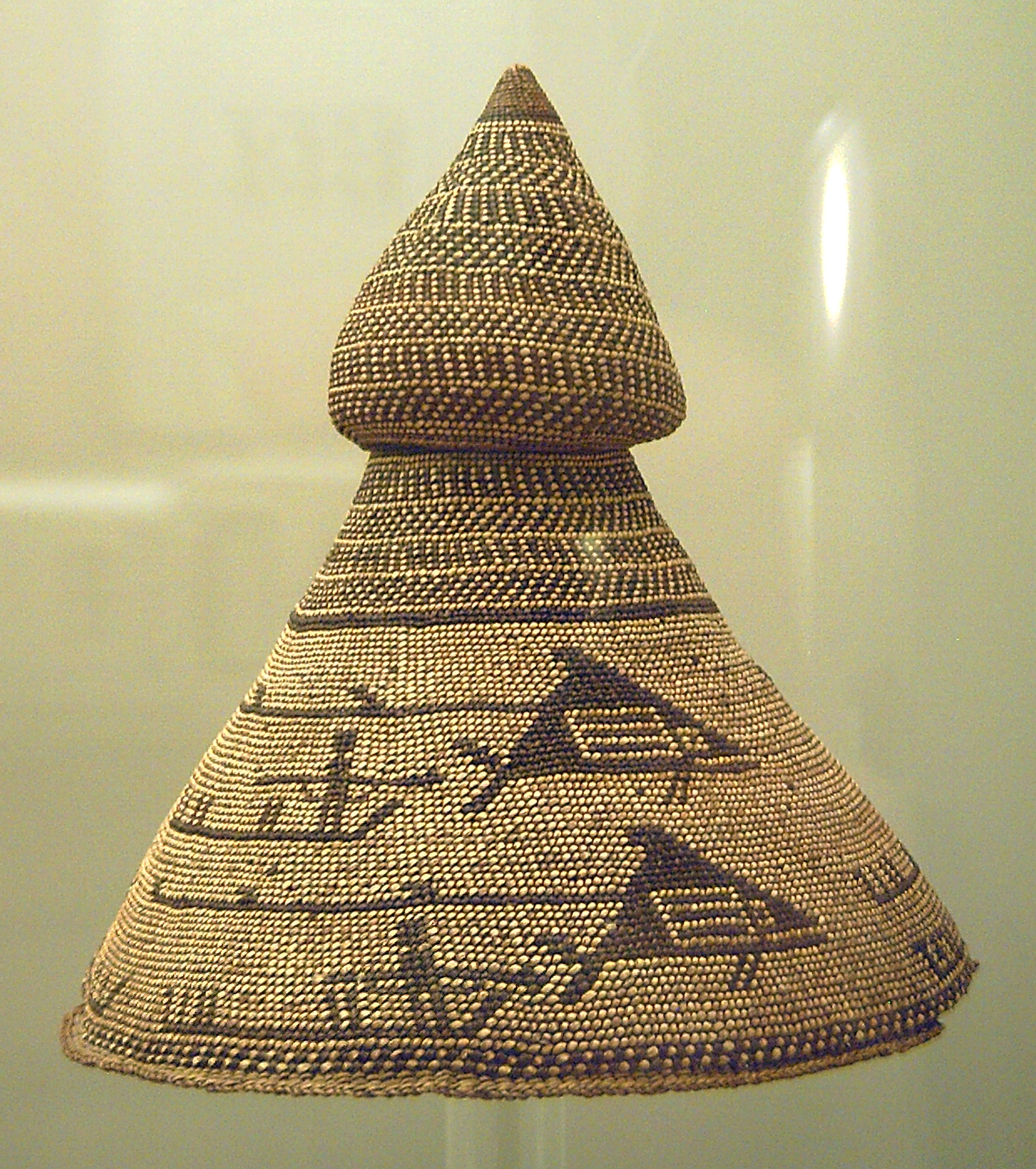
Cedar-fibre hat of a chief whaler, Nootka Sound, Vancouver Island, 18th c. (Museum of the Americas; image by Luis Garcia, 6 April 2008)
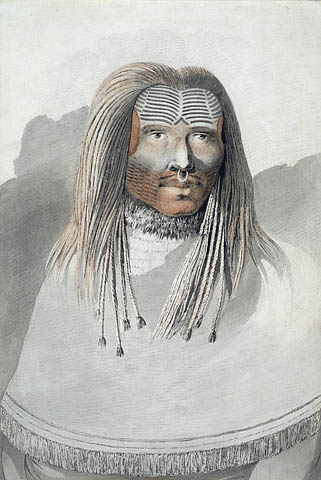
Man of Nootka Sound: George Webber, ship's artist, from James Cook: A Voyage to the Pacific Ocean, 1784 (Library and Archives of Canada)

Wolf's mask from Nootka Sound, Vancouver Island: collected by member of Capt. James Cook's crew, 1778 [?] (North American Department, Ethnological Museum, Berlin; image by FA2010, February 2009)

Friendly Cove, Nootka Sound, Vancouver Island: plate VII, Volume I, in Captain George Vancouver: Voyage of Discovery to the North Pacific Ocean and Round the World in the Years 1791-1795, published 1798 (NOAA)
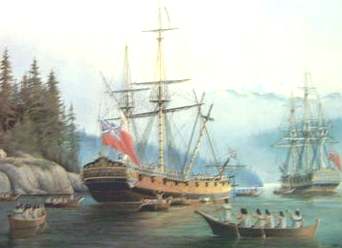
HMS Discovery under Captain George Vancouver, at Vancouver island, c. 1791: artist unknown

Captain George Vancouver's ship Discovery on the rocks in Queen Charlotte Strait. The ship ran aground in early August 1792 on hidden rocks near Fife Sound. Vancouver's second ship, Chatham, in the background in this scene, also ran aground on rocks within the day, about two miles away: artist unknown, from Vancouver: A Voyage of Discovery to the North Pacific Ocean, and Round the World, 1801 edition

The caneing in Conduit Street. Dedicated to the flag officers of the British Navy. Caricature showing a stout naval officer [Vancouver] attacked in front of the South Sea Fur Warehouse by Lord Camelford [Thomas Pitt, 2nd Baron Camelford], who says, "Give me satisfaction, rascal! Draw your sword..." Captain Vancouver replies, "Murder! Murder! ..." The print may reflect the growing discontent due to harsh naval discipline: hand-coloured engraving by James Gillray, published by H. Humphrey, 1 October 1796 (British Cartoon Collection, Library of Congress)
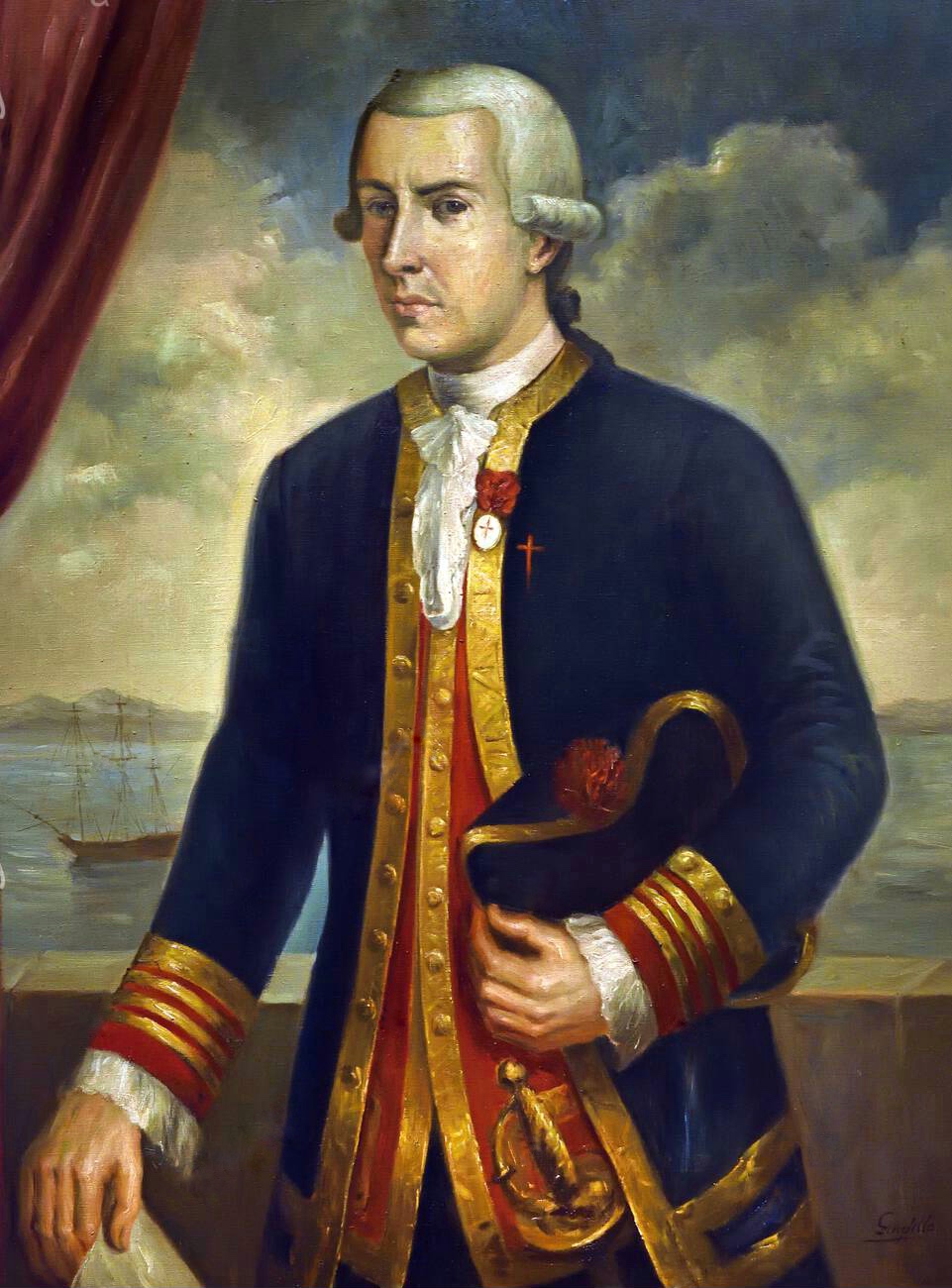
Tom,
ReplyDeletejohnny and I are wondering what happened to those two ships (the Discovery and Chatham) -- did they ever get them fixed?
Steve and Johnny,
ReplyDeleteBoth Chatham and Discovery made it off those rocks.
The two ships have interesting histories.
Vancouver's great Pacific Expedition (1791-1795) was in effect an extended maiden voyage for the 4-gun Royal Navy survey brig HMS Chatham. On the expedition she was commanded by Lieut. Wm. Robert Broughton, with 2nd Lieut. James Hanson as second-in-command. On Vancouver's orders Broughton took her up the Columbia as far as the Gorge. He reached what is now eastern Multnomah County (east of Portland), just northwest of Mount Hood (which he named), and made landing in 1792. Her command was shortly thereafter transferred to Lieut. Peter Puget (whose name survives in that of the Sound). In 1794 she was sent back to England with dispatches, under Puget. That return trip wore hard upon her. After major repairs at the Deptford ship yard she went back in naval service until 1830, when she was sold to a commercial trader in Jamaica. One would perhaps rather not know what cargos she may have carried then.
The HMS Discovery, the command ship in the expedition, was a full-rigged vessel with the standard crew of a hundred men. She had been built to order in 1789 for a voyage of exploration in the whale fisheries of the Southern Seas, for which reason she was given the name of the earlier HMS Discovery, the ship commanded by Cook on his third voyage into the Pacific.
George Vancouver had served as a midshipman on the Resolution during Cook's second voyage (1772-1775, in search of Terra Australis), and again on Cook's third voyage aboard the Resolution's sister ship, the earlier Discovery, on which voyage Vancouver was among the first Europeans to sight the Hawaiian Islands (the last sight Cook himself would ever see).
Late in the 1780s the Spanish, who had established a naval presence on the western coast of this continent a good deal earlier, commissioned their own surveying expedition to the Pacific Northwest.
Vancouver, who since his final voyage with Cook had been surveying coastlines as a lieutenant commanding the sloop HMS Martin, joined the surveying expedition of the Discovery as first lieut. under Captain David Roberts. But as war with Spain loomed over territorial and colonizing rights to the Northwest Coast, Vancouver and lieut. Joseph Whidbey went to the warship HMS Courageux. In 1790 the first Nootka Convention between the two great imperial powers removed the imminent threat of war, and Vancouver was given command of Discovery to take claim to Nootka Sound and survey the coasts.
He departed on this long voyage in 1791, charged, along with Broughton on HMS Chatham, to explore and map much of the Pacific. They went to Cape Town, Australia, New Zealand, Tahiti and China, surveying the coasts and collecting botanical samples.
ReplyDeleteAnd thence onward to the Northwest Coast, which Vancouver studiously followed and charted. Off the Oregon coast he encountered the Boston captain Robt. Gray, commanding the Columbia (the name of Gray's ship then became that of the river Broughton would sail up and explore, the following year).
Seeking the Northwest Passage, Vancouver on 29 April 1792 entered the Straits of Juan de Fuca, between what is now called Vancouver Island and what is now the state of Washington. He then proceeded to survey every little inlet and outlet all the way up to Alaska.
The problems with big ships running aground on rocks and sandbars always threatened, so that most of the inspection had to be conducted by small boats powered by oars and light sails.
A few days before his 35th birthday, in 1792, he became the first European to enter the inlet which is now the city of Vancouver's principal harbour area. In that vicinity he encountered a Spanish surveying expedition, and was shocked ("mortified" -- his word) to learn the Spaniards possessed a crude but useful chart of the Straits of Georgia, made the year before. After exploring those straits in company with the Spanish, he went back to Nootka Sound, the skin-trading capitol of the universe at that moment.
There he received for the Crown the title to Spanish holdings in the place; and exchanged maps with the elegant and congenial Bodega y Quadra.
It was in September of that year that Vancouver and the Spanish captain were entertained at Nootka by the local head chief, Maquina. After the meeting, the two captains decided to name the island after themselves. But as the years went by and the Spanish presence became but a distant memory, Vancouver's was the name that stuck.
It was after that that Vancouver sent Broughton up the Columbia in the Chatham; though again, there, much of the close inspection work had to be done with small boats.
Vancouver continued his explorations for three more years. When he returned to England in 1795 he was beset by nagging difficulties; the Gillray cartoon refers to an assault upon his person, in the street, by Thomas Pitt, 2nd Baron Camelford, whom he had once disciplined at sea. There was public embarrassment. Vancouver lost his career. He died in obscurity at age forty, a short three years after having circumnavigated the globe on behalf of crown and country.
Naval records show that in four years upon the world's oceans under Vancouver, HMS Discovery lost only six men, a remarkably low number given the time and circumstances; and all of these deaths came by accidents at sea, none from the more common causes of scurvy and violence.
After four years at sea, Discovery was in pretty bad shape. She lay in dock for three years, then was refitted as a bomb vessel, in which role she was employed in the battle of Copenhagen in 1801. Later that year Nelson used her as a bomb vessel to attack a French flotilla off Boulogne.
Heavy damage again, but two years later Discovery was back at sea as a hospital ship, at Sheerness.
Her decline continued. In 1818 she was put to use as a convict ship off Woolwich. Six years later she was removed to Deptford for use in the same sad capacity.
HMS Discovery in an embarrassed state, as a convict ship at Deptford.
In 1834 she was finally broken up and became part of the detritus of the river.